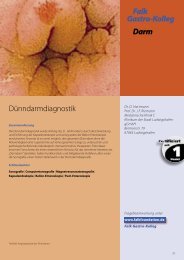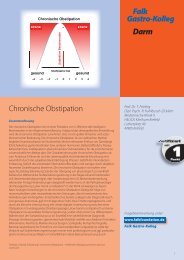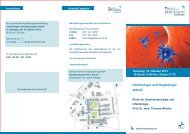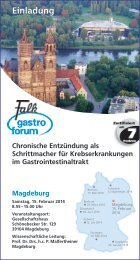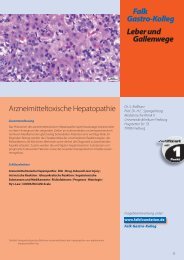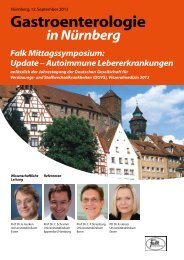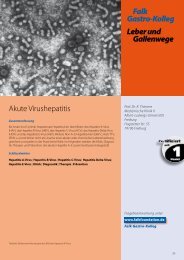152 153 Intestinal Disease Meeting Berlin 2006 - Dr. Falk Pharma ...
152 153 Intestinal Disease Meeting Berlin 2006 - Dr. Falk Pharma ...
152 153 Intestinal Disease Meeting Berlin 2006 - Dr. Falk Pharma ...
Create successful ePaper yourself
Turn your PDF publications into a flip-book with our unique Google optimized e-Paper software.
(Düsseldorf) cited the development of ultrathin<br />
gastroscopes that now permit transnasal<br />
gastroscopy (figure 1). “Unlike in France,”<br />
H. Neuhaus said, “this method, which enjoys<br />
high patient acceptance, has yet to become<br />
established in Germany.”<br />
An objection to transnasal endoscopy has been<br />
that the resolution is inferior to that provided<br />
by conventional endoscopes. According to<br />
H. Neuhaus, however, the resolution is no longer<br />
a problem with the newer units. Because of<br />
the small navigation mechanism, the ultrathin<br />
endoscopes have the advantage of being able<br />
to inspect directly behind mucosal folds – an<br />
Fig. 2<br />
H. Neuhaus<br />
I Chromoendoscopy: Methylene blue staining of Barrett’s metaplasia<br />
(H. Neuhaus, Düsseldorf)<br />
Congress Short Report <strong>Falk</strong> Symposium <strong>152</strong><br />
important capability, such as in the search for<br />
esophageal carcinomas. Potential indications for<br />
the new method, H. Neuhaus said, would include<br />
diagnostic esophagogastroduodenoscopy<br />
(EGD) without sedation, screening for Barrett’s<br />
esophagus, dysphagia work-up, transnasal tube<br />
placement and passage of high-grade stenoses<br />
in the proximal gastrointestinal tract.<br />
Chromoendoscopy: better<br />
evaluation of lesions<br />
Another example of progress is the method of<br />
chromoendoscopy (figure 2), which, because of<br />
the color technology, enables a better evaluation<br />
of lesions. “In particular, lesions are much better<br />
demarcated,” H. Neuhaus explained. One method<br />
that has not gained broad acceptance is the<br />
technique of zoom endoscopy, which, despite<br />
its capabilities for magnification, does not offer<br />
any advantages over conventional methods. In<br />
the general, the reliability of findings returned<br />
by endoscopic examinations depends to a great<br />
degree on the quality of patient preparation and<br />
the examination technique. The exact clinical<br />
utility of further increases in resolution is difficult<br />
to assess, but would seem helpful.<br />
5



